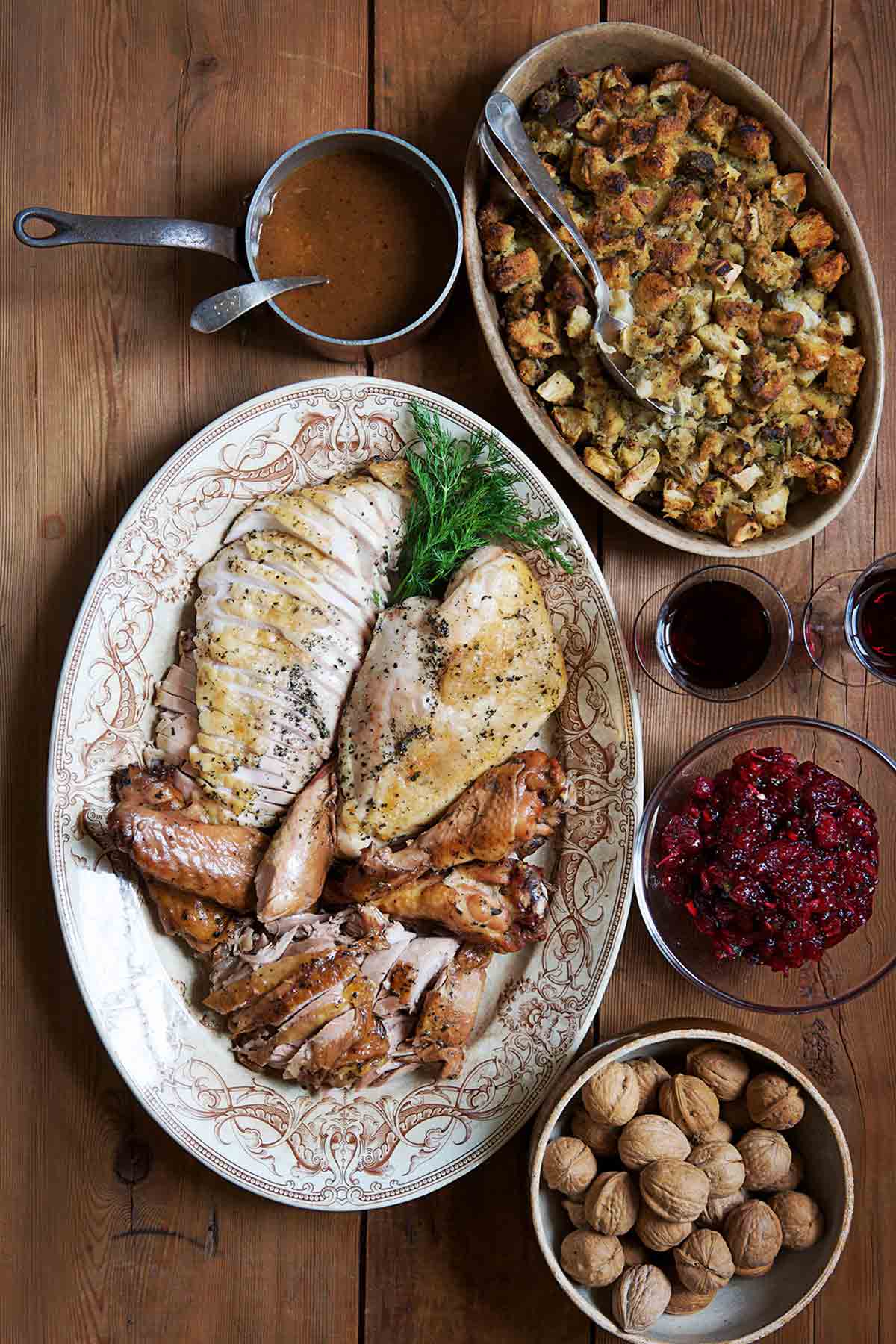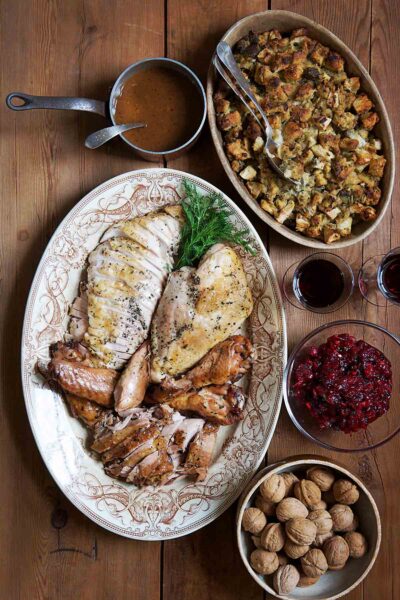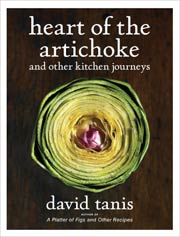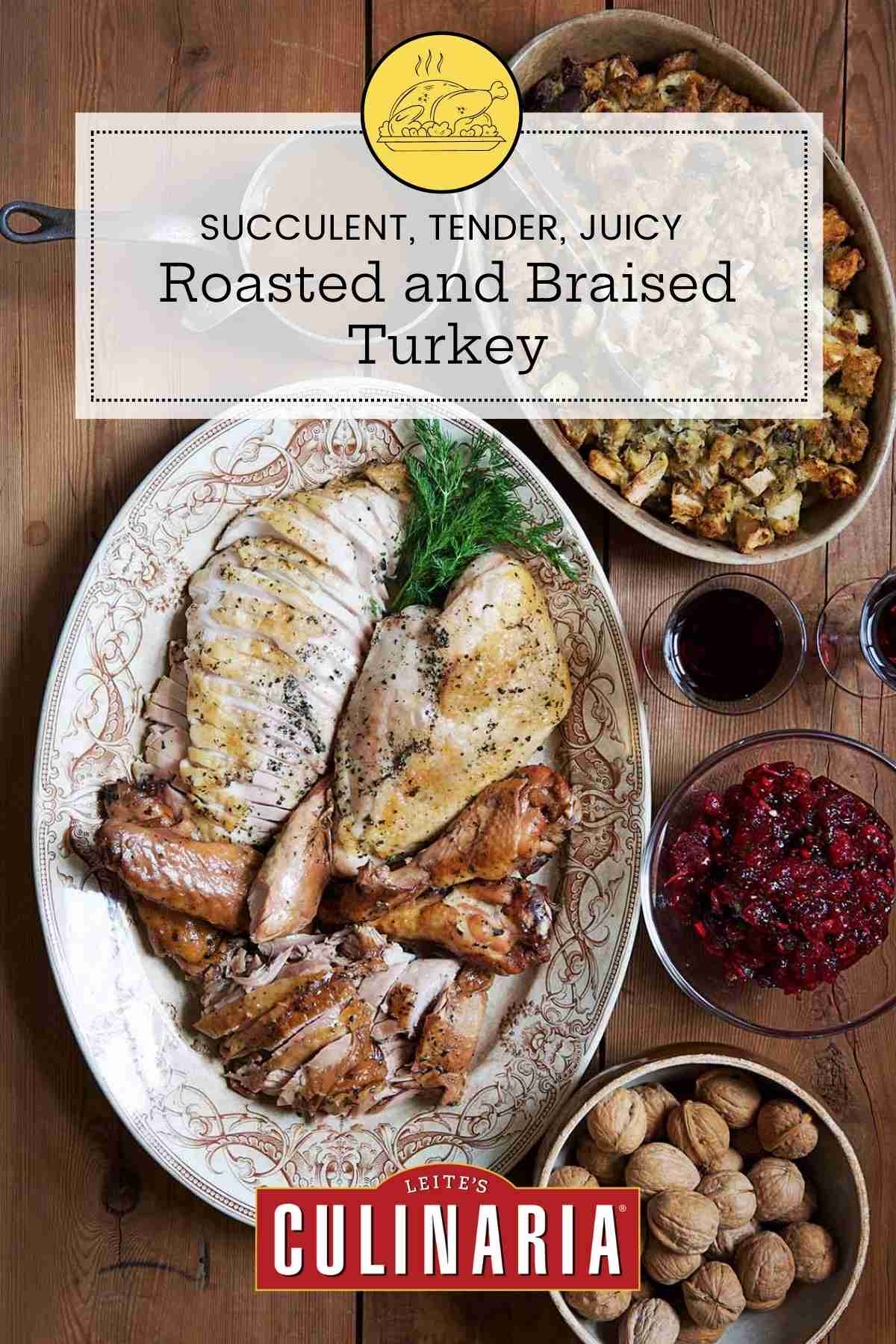
Heresy.
Blissful, succulent, turkey-induced heresy.
Want to save this?
That’s what this unconventional tactic from chef David Tanis of Chez Panisse makes us think. Tanis allows us to circumvent the usual turkey roasting conundrum—the maddening trickiness inherent in trying to cook a turkey until the dark meat is done without punting the white meat into dry oblivion—by bucking tradition and cooking the dark and white meat separately. The legs luxuriate in a long, slow, wine-sloshed bath with aromatics, simultaneously being braised and tenderized and infused with fragrance and flavor. The breast simply gets blasted by a hot oven, just long enough to plump it, no longer. Of course, this untraditional technique preempts the pretense of carving at the table. We’re not certain that’s such a bad thing.
One last thing. Remember that the secret–well, the other secret–is to season the turkey overnight. So just a reminder, you’ll need to begin things the day before.–David Tanis
LC Essential Butcherspeak Note
Tanis savvily suggests you ask your butcher do the heavy chopping for you. Simply request-nicely, please–for the turkey legs to be lopped off with the thighs attached, for the wings to be hacked from the body, and for the breast to be cut into 2 boneless but skin-on halves. While you’re at it, smile sweetly and request that what remains of the carcass be chopped up into large pieces for your stock. (Make sure to request the giblets, too.)

Roasted and Braised Turkey
Ingredients
For the “brine”
- One (12- to 14-pound) turkey, cut into six parts (as above)
- Salt and freshly ground black pepper
- 1 small bunch sage leaves, finely chopped
- 1 small bunch thyme, leaves stripped and finely chopped
- 6 garlic cloves, smashed to a paste with a little coarse salt
- 2 tablespoons olive oil
For the broth
- Carcass and bones and leftover parts from your turkey , (or about 3 pounds [1.3 kg] other poultry bones)
- 1 large onion, peeled, halved, and stuck with 1 clove
- 1 carrot, peeled and chopped
- 1 celery stalk, chopped
- 2 bay leaves
- 2 or 3 slices dried porcini mushrooms
- About 6 quarts water
For the braise
- 3 tablespoons butter
- 2 large onions, chopped
- Salt and freshly ground black pepper
- 3 tablespoons all-purpose flour
- 1 tablespoons store-bought or homemade tomato paste
- 1 cup dry red wine
For the garnish
- Parsley or watercress sprigs
Instructions
Brine the turkey
- Place all the turkey pieces on a cutting board and season well on both sides with salt and pepper. Mix the sage, thyme, and garlic in a small bowl. Add the olive oil and spoon the mixture over the meat and under the skin and smear it in well. Place the legs and wings in a container, cover, and refrigerate. Wrap the breasts in plastic and refrigerate overnight.
Make the broth
- Preheat the oven to 400°F (204°C). Place the turkey bones, onion, carrot, celery, and bay leaves in a roasting pan and into the oven. Roast for about 30 minutes, stirring occasionally, until everything is nicely browned.
- Transfer the browned vegetables and bones to a big soup pot. Splash a little water into the roasting pan and stir to dissolve any tasty bits left in the pan, then pour the liquid into the pot. Add the dried mushroom and water and bring to a boil. Skim off the scum, turn the heat down to a simmer, and let it cook slowly for 11/2 to 2 hours.
- Strain the broth through a sieve. You should have about 5 quarts of turkey broth. Cool, then refrigerate; when ready to use, skim off the fat that has risen to the surface.
Roast the turkey
- Preheat the oven to 400°F (204°C). Put the legs and wings in a large roasting pan, making sure they have enough room so they’re not crowded. Put the pan in the oven and let the parts roast while you prepare the braising liquid.
- In a large skillet over medium heat, melt the butter. Add the onions and season them with salt and pepper. Let them cook gently, stirring occasionally, until softened, about 10 minutes. Turn up the heat and let the onions color a little bit. With a wooden spoon, stir in the flour and tomato paste and mix well. Slowly add first the red wine and then 2 cups of the turkey broth. Bring to a simmer, stirring almost constantly as the sauce thickens. Gradually stir in 2 more cups of broth and stir until the sauce thickens once again. Remove from the heat.
- Remove the pan of legs and wings from the oven. They should be nicely golden but not too dark. Pour the braising liquid over the turkey parts, cover the pan tightly with foil, and return to the oven. Reduce the heat to 350°F (176°C) and braise the turkey for about 1 1/2 to 2 hours, depending on the size of your bird, until the legs are tender when tested with a fork. Transfer the braised turkey legs and wings to a cutting board and let them cool slightly.
- Strain the braising liquid through a fine-mesh sieve into a saucepan, skimming off any fat that rises. This will be your gravy. Taste the sauce for seasonings and texture. If it’s too thin, reduce it a bit over medium heat until it reaches a consistency you like. Set aside. (The braised turkey process can be done hours ahead or the day before and refrigerated.)
- When the braised turkey parts are cool enough to handle, remove the leg meat from the bones in large pieces and tear the meat from the wings. Cut the meat into rough slices and put in a baking dish. Cover and hold at cool room temperature.
- Meanwhile, remove the breasts from the refrigerator and let them come to room temperature. The breasts will take only about a half hour to roast, so they can be started up to an hour before dinner in a 375°F (190°C) oven. Put them in a shallow roasting pan, skin side up, and into the oven. Check at 30 minutes—you want an internal temperature of 140°F (60°C). (The temperature will continue to rise as they rest.) Let them rest on a platter, loosely covered, for 15 to 30 minutes before carving.
Serve the turkey
- Slice the turkey breasts on an angle, not too thickly. Arrange the turkey on a warm platter and garnish with parsley or watercress.

Explore More with AI
Nutrition
Nutrition information is automatically calculated, so should only be used as an approximation.











I’m planning on making this for this Thanksgiving. Question: Is it really OK to take the breasts out at 140? After resting what will the temp be? Thank you!
Hello, Meagan. None of my testers had a problem with the temperature, and I went through the comments, and none of our readers did. But if you want to be on the safe side, you can roast the breast until it reads 150°F to 155°F. Pulling out the breast at that temperature will definitely allow it to reach proper temperature after resting.
I’ve been making turkeys for 45 years and have tried every new fangled method that has come along. I thought I had finally settled on the one true method when I spatchcocked and roasted one in my kettle grill. Yesterday, I heard this technique mentioned on a podcast and it intrigued me.
A quick google search led me to this page and I’m glad it did. I’m making it this year.
Thanks for all the great recipes and writing you do. Love your podcast as well.
Bkhuna, thank you for the kind words. Do let me know how it turns out.
Marvelous.
I did a very simple dry brine of kosher salt and herbs and let the pieces sit wrapped for two days and them dried and uncovered on a wired rack in the fridge overnight the evening before the cook.
The juicy, tender, and flavorful dark meat and perfectly cooked white meat with crispy skin and succulent meat made this the top contender for repeat cooks.
Thank you so much.
Bkhuna, do you know you’re one of our longtime power users? Really! I’m so delighted that it came out so well.
Thank you so much for this recipe! Our family loves it–I’ve been making it for years.
One question: why does the recipe ask users to make so much stock? As far as I can glean (after years of making this), only 4 cups of stock are used for the actual recipe. I realize that the stock can be used for other purposes or frozen, but asking home cooks to make 6 quarts/24 cups of stock seems to me to be overkill. Over the years I’ve reduced the stock to 3 quarts (which still leaves a lot of leftover stock). It might be worthwhile to let folks know that they can make much less stock if desired. And maybe give some suggestions on what to do with all of the extra. Thanks again!
Jeanne, many thanks for letting us know you fancy this recipe as much as we do! And that’s an excellent question. The answer is partly as you surmised, which is that while you’re making stock, you may as well have some extra to stash in the freezer for another use. The rest of the reason it calls for 6 quarts water is because that’s the ratio of water to a single turkey carcass that results in a nicely flavorful, but not too intense, stock. It’s easier to cut the recipe down if using chicken parts, which are given as an option, but the author was going for a subtle turkey flavor here, and so we kept the amounts the same out of respect for that, as it’s unlikely that someone would use half a carcass. As for what to do with the leftovers, so lovely that you asked! Below are some of the soups that always come to mind when I have ample stock on hand…
Mexican Chicken Soup
Vietnamese Chicken Rice Soup
North African Chicken Soup
Thank you!
Of course, Jeanne!